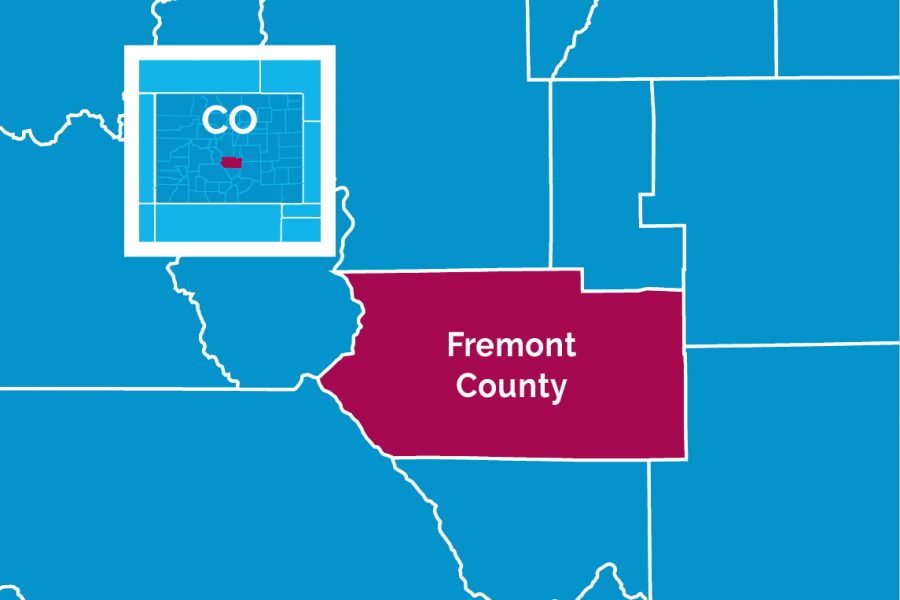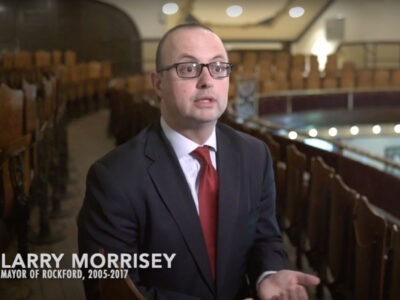COVERAGE AREA
City: Cañon City
Counties: 1
Total Population: 47,839
The Achievement
FUNCTIONAL ZERO FOR VETERAN HOMELESSNESS
- Milestones Reached: Veteran (2021)
- Next Population for Focus: Chronic homelessness
The resourceful Fremont County team made incredible strides since joining Built for Zero in 2019, as a sub-region of the Colorado Balance of State Continuum of Care. The Built for Zero Collaborative, a movement of more than 80 communities committed to measurably ending homelessness, one population at a time.
In February 2021, Fremont County reached functional zero for veteran homelessness, demonstrating that there are fewer veterans experiencing homelessness than can be routinely housed within a month, which is three veterans in Fremont County.
By reaching functional zero for veteran homelessness, the community has proven it has built a system that can ensure homelessness is rare and brief, even if new veterans experience housing crises over time.
“The folks that have been on the improvement team were all determined to do this,” said DeeDee Clement, Executive Director for Loaves and Fishes Ministries and the Fremont County Community Lead. “We felt like we could do it, we weren’t sure how we were going to do it, but we felt it was something our community could achieve.”
Officially joining the Built for Zero Collaborative proved to be an inciting event on their journey to ending veteran homelessness. Bethany LaLoge, Community Base Child Abuse Prevention Coordinator and BFZ Homeless Outreach Coordinator at Starpoint, recalled learning about the successes other communities in Built for Zero had in reducing and ending homelessness, as she remembered saying, “Wow, this is actually a solution that can practically get people to housing successfully.”
Amanda Allen, Regional Housing Director, Upper Arkansas Area Council of Governments, agreed: “Having that additional support and guidance from Built for Zero changed the game for us.”

The Challenges
The Fremont County Built for Zero community faced several challenges in their path to reaching functional zero for veteran homelessness. These included:
- Low resources. Fremont County had few resources at their disposal to conduct their housing efforts. This included having no paid outreach staff and, crucially, no funding for a designated housing navigator.
- A rural environment. The sprawling, rural locale of Fremont County caused additional barriers to locating and supporting their unhoused neighbors and getting them connected to services.
- A lack of a robust case conferencing practice. The team realized that they needed a more consistent and comprehensive veterans-only case conferencing meeting to fully engage the resources and knowledge across the community.
How did they do it?
As part of Built for Zero, Fremont County changed how its homeless response system works by adopting the core elements of the Built for Zero methodology:
- Building a unified regional team, or a “command center” around a shared aim of getting to functional zero.
- Using real-time, person-specific data to know every veteran experiencing homelessness by name and target efforts and resources accordingly.
- Using data to redesign Fremont County’s homeless response and strategically target resources.
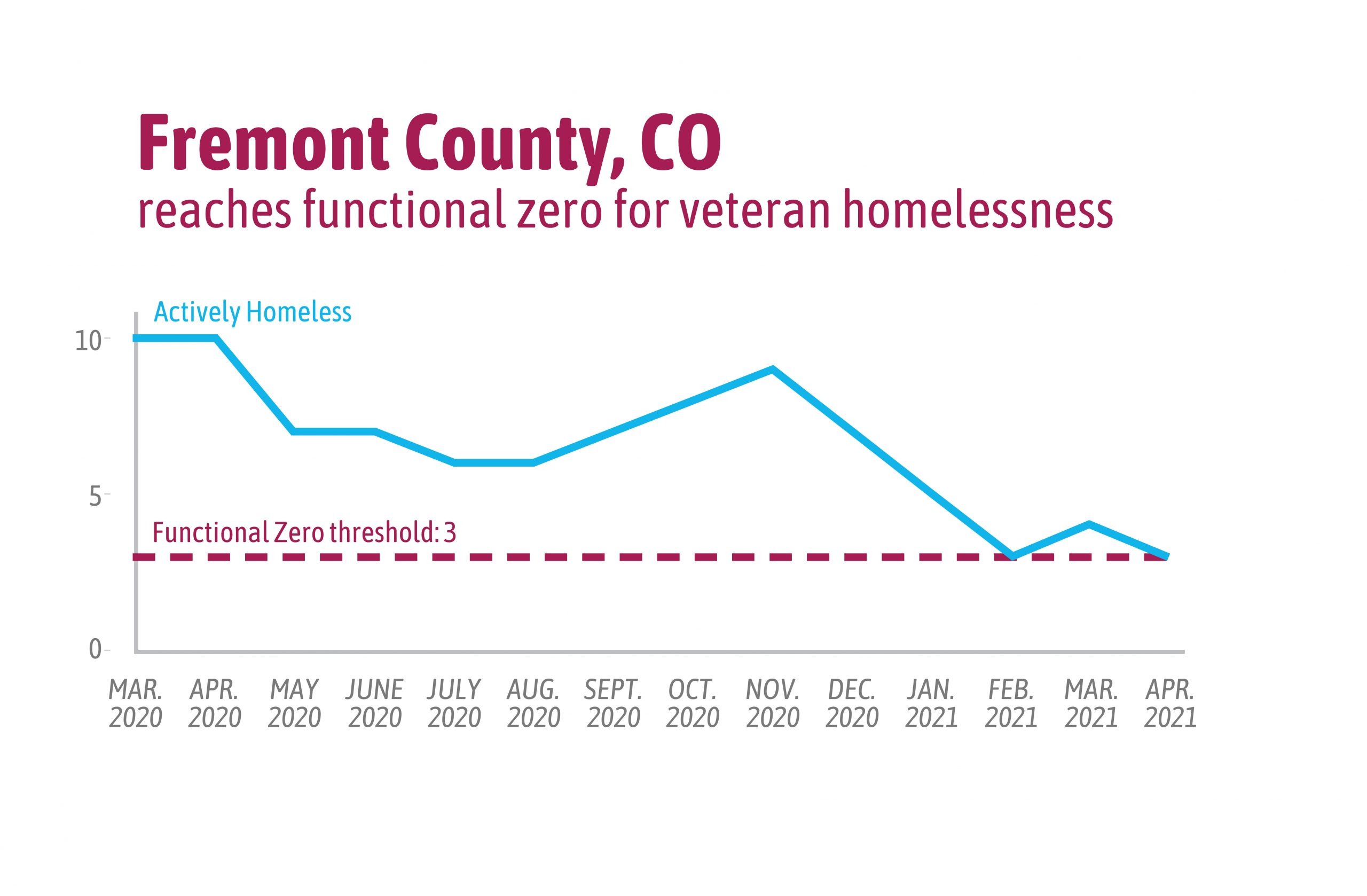
ASSEMBLING A UNITED COMMAND CENTER
The local Built for Zero team started by unifying the efforts of key agencies working locally to end homelessness. In many communities, local agencies or nonprofits focus on their piece of the solution, without an ability to see how all the pieces in their community fit together. Often, success is defined by each organization’s programmatic goals rather than whether the overall number of people experiencing homelessness decreases.
Fremont County worked to reorganize their efforts around a shared goal of getting to zero on veteran homelessness. They built a committed, solutions-focused, and resourceful team, while also securing buy-in from their mayor and other city and county government officials. The state Department of Local Affairs, Division of Housing, also provided integral support on a larger scale, helping clear the path for the local team to overcome barriers keeping people from getting housed.
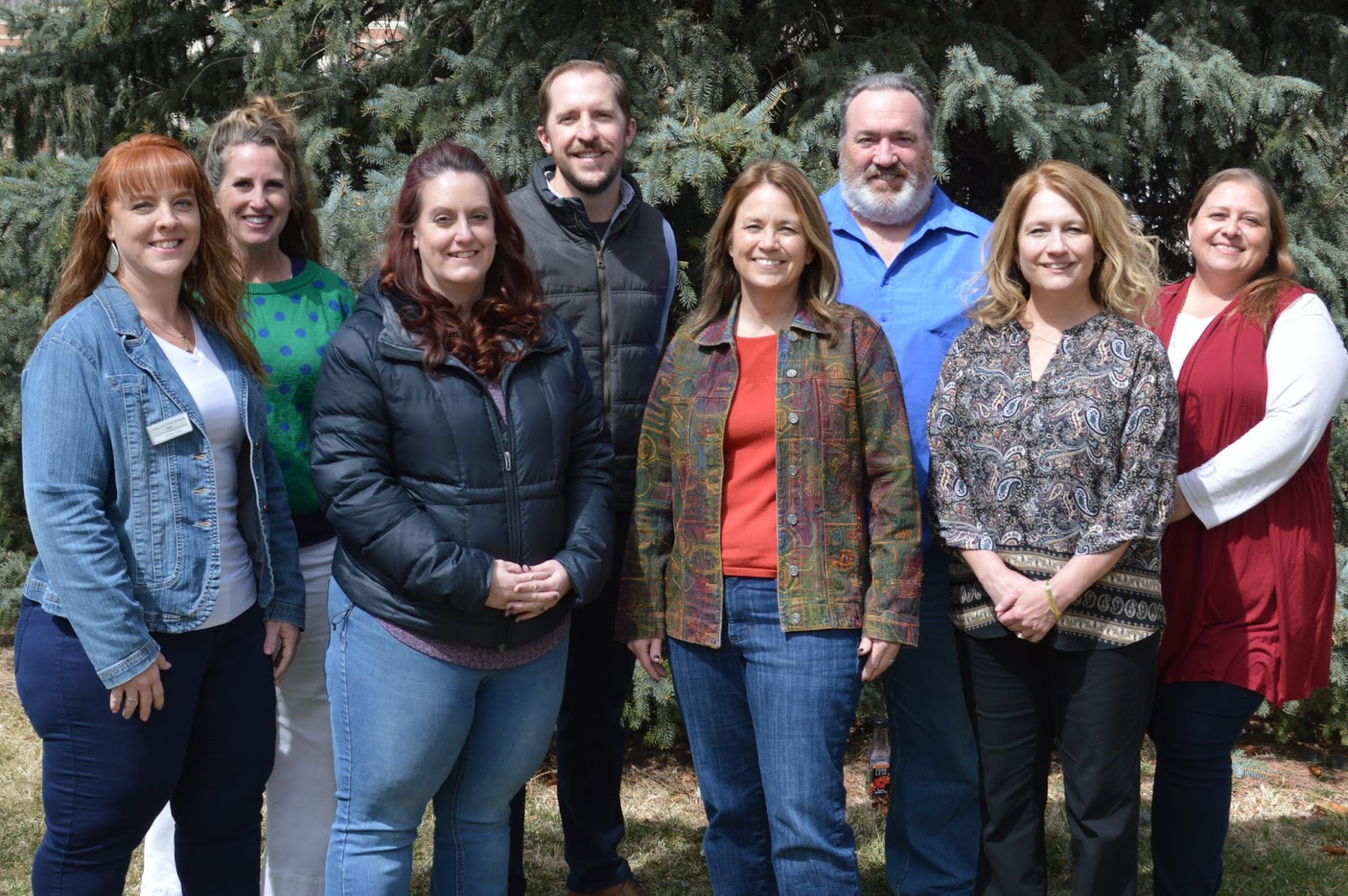
“We had all the right people around the table who were good in their specialized area, and everyone was committed to the cause,” Clement said. “Everyone was like ‘Yes, I want to be part of this team.’”
This unified group was willing to set goals, in spite of immediate hurdles in their path, like responding and adapting to the Covid-19 pandemic. As Clement noted, the larger command center team works well together and they’re not trying to compete with each other or lift up one agency or person over another. “We’re just here to solve a problem,” she said.
These problem-solvers were guided by the dynamic DeeDee Clement, who served as the Built for Zero Community Lead. “She’s a leader who has earned respect and loyalty out of her history demonstrating her good-spirited work,” noted Sandy Colts, Built for Zero Improvement Advisor for Fremont County. “She rules with a very soft, well-deserved hand of kindness and optimism. And that’s not easy for people to achieve when they are in a low-resourced, rural setting doing thankless work.”
UNDERSTANDING THE PROBLEM THROUGH QUALITY REAL-TIME DATA

You cannot solve a problem that you don’t understand. In order to measurably end homelessness, communities need real-time, person-specific data. Traditionally, an understanding of the issue of homelessness in a community has been limited to an annual, federally-mandated estimate of people experiencing homelessness, called the point-in-time count. This exercise provides a yearly estimate of how many people experience homelessness on a single night in a given community, but does not include the names or needs of the people who make up that number.
Communities in Built for Zero compile by-name data, which provides real-time insights into everyone experiencing homelessness by name. This enables communities to triage that individual’s needs, understand if their investments and activities are driving homelessness down, and test ideas that will move people out of homelessness faster.
A key challenge the community faced was an insufficient process for completing and reporting assessments of individuals’ housing and health status. These assessments allow case workers and providers to match veterans experiencing homelessness with the programs and services that best meet their needs. However, the data gleaned from the assessments is only valuable if accurate and comprehensive, and the Fremont County team was short on staff members trained to administer assessments. To address this shortage, they trained 125 people across 15 community agencies to complete what is called the VI-SPDAT Assessment, which in turn improved the quality of their by-name data and allowed them to better serve their clients.
By March 2020, the team had created a system that ensured quality data on every veteran experiencing homelessness. This data enabled them to understand who was moving out of homelessness, who was entering into it, and who was remaining on the list.
“Now, when we talk to people, we can say pretty confidently that last night there were 175 people that slept outside,” said Clement. “Because we know that, because we have a list of names and contact information, and our outreach team are connected with them.”
USING DATA TO REDESIGN FREMONT COUNTY’S HOMELESS RESPONSE AND TARGET RESOURCES
Focused case conferencing
Once they began having more confidence in their data, the team began meeting on a bi-weekly basis to talk about the veterans on their by-name list for the first half of the meeting, followed by people on their chronic by-name list.
But as Jennifer Jones, Coordinated Entry System Program Manager at Loaves and Fishes Ministries, explained, they knew something had to change. “We recognized a few months in that, if we were going to be intentional about getting to functional zero for our veteran population, we needed to get a few more people around the table on a more regular and consistent basis.”
The team began meeting weekly to discuss the veterans on their by-name list through a deliberate and strategic practice called case conferencing: a recurring, problem-solving meeting where key participants convene to collaborate on ways to remove barriers to help house clients faster. Every person on their by-name list is discussed and connected to and assigned support. “That helps make the people real when doing case conferencing,” commented Clement. “There’s someone there who knows what’s happening in that person’s world. It puts a face to the person experiencing homelessness.”
LaLoge noted that holding a recurring veterans-only case conferencing meeting was when she really saw housing gear up and the veteran functional zero goal in sight. All of the pieces and processes they had put in along the way were stepping stones to strengthening their system. “Case conferencing has given our community a better focus on ending homelessness,” LaLoge said. “With the process we have in place now, we’re moving in leaps and bounds.” When they began, they had over 10 veterans on their by-name list, and since March 2020 they reduced that number down to three by February 2021. “So something’s working. I have seen a ton of results.”
When the Covid-19 pandemic started in the spring of 2020, Fremont County reached the quality data threshold. They had just begun holding high-energy, in-person case conferencing meetings and had to switch to virtual meetings, which challenged not only the dynamic but attendance numbers as well. Ever resourceful and determined, the team did not let that slow their work down, and their case conferencing practice regained momentum via Zoom, giving them better access to client documentation and speedier processing of leases with the move to a fully virtual environment.
As in many other communities across the country, Fremont County temporarily housed many of their most vulnerable people experiencing homelessness in hotels and motels during the pandemic, in order to de-congregate shelters and provide a safe place for quarantine and isolation. This, however, did not slow down the housing process, as the team sought to maximize having their clients all in one location. As Jones noted, the driving question became, “How do we keep these men and women moving forward as well, engaging them in services, and supporting them where they’re at?”
Outreach from the community
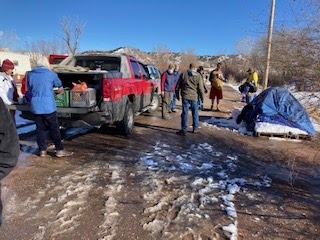
“There’s been such an outpouring of love and support from the community. It’s kind of taken on a life of its own…It has grown leaps and bounds.” – Bethany LaLoge
Ending veteran homelessness takes not only concentrated efforts of those within the homeless services sector, but alignment across the wider community as well. Many residents of Fremont County wanted to support their veteran neighbors in crisis, so the Fremont County Built for Zero team held an educational event to inform the community about their goal. The team discovered that a lot of people had been conducting outreach work already, but just had not communicated or collaborated with others. Beginning in January 2020, community organizations and volunteers in Fremont County started organizing outreach efforts, with the first official community outreach event taking place in May 2020.
These community events helped them amass an email list of about 90 people who they could email weekly and regularly invite to events, resulting in around 20 regular volunteers with 30 others on rotation. “There’s been such an outpouring of love and support from the community,” LaLoge commented. “it’s kind of taken on a life of its own…It has grown leaps and bounds.”
One outreach volunteer even became a staff member for one provider called Loaves and Fishes, taking on an outreach case manager position. “There are quite a lot of people who not only have the heart for this but the passion to go out and help these folks,” LaLoge explained.
Additional outreach has improved by-name data quality, assessment, and case conferencing, helping more veterans get connected to resources. As the community coverage improved, their numbers of newly identified veterans experiencing homelessness increased, adding to their by-name list. However, their system could lean on accurate and consistent data, which allowed the team to plan for these increases and drive the number of people on their list back down again.
“I can’t imagine where we would be if we didn’t have this outreach team,” commented Stacie Kwitek-Russell, Director of the Fremont County Department of Human Services. “They really helped us keep our data real and keep our by-name list where it needed to be, and [provide] the support for individuals experiencing homelessness.”
Rounding up additional resources
As with many other communities across the country, Fremont County often lacked sufficient resources to prevent and resolve homelessness — requiring creative solutions, strong community partnerships, and abundant resourcefulness to continue housing people. After working hard to improve their data and Coordinated Entry systems, Fremont County was awarded additional permanent supportive housing vouchers through the Balance of State CoC, which helped them house veterans experiencing chronic homelessness and ultimately reach functional zero.
Additionally, pass-through funding from the Ballmer Group provided a flexible funding pool that assisted in housing people with greater needs, helping cover a variety of expenses like transportation or longer-term rental support that would have otherwise been unattainable. “It’s just nice knowing that we have those funds available to help with those things that come up,” Clement said.
When faced with a shortage of affordable housing options, the team was encouraged by their Built for Zero coaches to explore increased landlord engagement. “We’ve really been trying to develop relationships with our landlords and as we think about the future that’s something we want to continue to work on,” Clement said.
One barrier they faced in increasing their outreach efforts was the lack of a designated Housing Navigator — a staff member who focuses on helping clients with their housing searches and placements. With funding from a new grant becoming available, the team decided that hiring for that role was the best way to utilize that money. “The housing navigator has been pivotal,” said LaLoge.
Even as their enhanced outreach program started identifying a greater number of people experiencing homelessness, having a dedicated Housing Navigator enabled them to keep driving their numbers down to functional zero. Since reaching and sustaining their veteran homelessness goal, the Navigator now also helps families and other individuals find housing.
What’s Next
PROTECTING ZERO
After reaching functional zero for veteran homelessness, Fremont County’s next goal is to reach functional zero for chronic homelessness. This will require continuing their thoughtful work and increasing overall community engagement. The team is determined to sustain their veteran functional zero achievement, and even aim to continue improving by reaching absolute zero for veteran homelessness. They don’t plan to take the easy route here, but rather continue expanding their outreach efforts to more rural parts of the county to ensure their by-name data includes every veteran experiencing a housing crisis.
Clement noted that they will continue striving to know and help all of their neighbors experiencing homelessness, ensuring they are on the team’s radar and know they have the community’s support. “At least that person sleeping on the street knows that every two weeks, there’s going to be a phone call from someone who cares and is checking in on them to see how they are doing and if there is something we can help with,” said Clement.
“Even though we can’t offer housing to them at the moment, they matter to us — these are our neighbors. We care about them. We want them to be in homes.”

Timeline
2019
- October: Fremont County joins Built for Zero, with support from Kaiser Permanente
2020
- March: Reached quality data on veteran homelessness.
2021
- January: Received Ballmer Group support for flexible funding pool and Colorado Health Foundation grant for pass-through money to build local capacity
- February: Fremont County reaches functional zero for veteran homelessness
Who was on the team?
Community Lead:
Deidra “DeeDee” Clement
Executive Director, Loaves and Fishes Ministries
Data and HMIS Lead:
Jennifer Jones
Coordinated Entry System Program Manager, Loaves and Fishes Ministries
Veteran Improvement Team:
Bethany LaLoge, Starpoint
Marty Peak, VSO
Ben Strand, SSVF
Stacie Kwitek-Russell, DHS
Amanda Allen, Regional Housing Director, Upper Arkansas Area Council of Governments
Heather Engle, Solvista Health
Brian Turner, Solvista Health
Anna Carochi, Solvista Health
CoC Champion Lead:
Mayor Ashley Smith
Outreach Coordinators:
Heather Engle
Care Manager, Solvista Health
Bethany La Loge
Community Base Child Abuse Prevention Coordinator and BFZ Homeless Outreach Coordinator, Starpoint
Outreach Case Manager:
Lorie Stone
Outreach Navigator/Case Manager, Loaves and Fishes Ministries
PHA Lead:
Amanda Allen
Regional Housing Director, Upper Arkansas Area Council of Governments
Lead Volunteers:
Reta Martinez, Jolynn Hall, Peg Blackwell, Jack and Janet Hagen, Patty Schlesinger, Patricia Stiller, Denny and Darla Carpenter, Ruth Farmer
Built for Zero Coaches:
Partner Agencies:
Starpoint Family Resource Center, DHS, CCPD, Solvista Health, Valley Wide Health Services, Veteran Services, Journey Home, UAACOG, Mercy Today Ministries, First United Methodist Church, St. Michael’s Catholic Church, The Shed Yard, Knights of Columbus, Unbridled Acts, New Horizons, Manna House, Motel 6, Canon City Parks Department, The Golden Belt Byway Group
